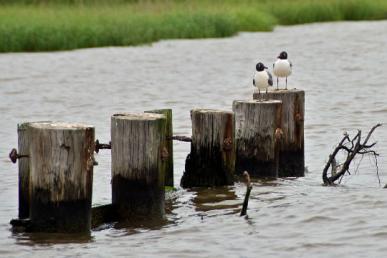A Louisiana native's determination to rebuild her state's wetlands
Recently I took part in a flyover of the Mississippi River Delta. As the newest member of EDF’s Mississippi River Delta Restoration Team, the experience was eye-opening and exhilarating. As a south Louisiana native with a lifelong passion for wetlands, it was heartbreaking.
Soon after taking off from the Southern Seaplane Airport near New Orleans, we headed southeast, with the Mighty Mississippi on our left and the Mississippi River Gulf Outlet (MRGO) on our right. Below us lay wetland – or what should have been wetland but was more wet than land.
From our bird’s-eye view, the area, which had been starved of freshwater and sediment due to man-made levees along the Mississippi River, resembled a moth-eaten wool sweater. The wetland below me was full of different sized holes with jagged, irregular edges. As we flew on, Lyle, our pilot and guide, pointed out several small areas that had, for one reason or another, remained connected to the Mississippi River over the years. Those wetland areas had fewer, much smaller holes; some had no holes at all.

Laughing Gulls, Coastal Louisiana birds. Image credit: Shannon Cunniff, EDF
What is significant about these holes, which used to be wetland? Well, among other things, bigger holes = less wetland area. Less wetland area = less buffering from storms. Coastal wetlands are an integral part to any hurricane risk reduction system, serving as a buffer and retention area for storm surge. The reduction of storm surge is essential to keeping the communities of south Louisiana, including New Orleans, safe during big (and “little”) hurricanes.
Louisiana’s wetlands are subsiding, compacting, drowning and dying. Since 1930, Louisiana has lost 25% of its coastal land area, approximately 1,900 square miles (an area almost as large as Delaware) and continues to lose land at an alarming rate. Between 1985 and 2010, it is estimated that Louisiana lost land at an average rate of one football field every hour. That adds up to 450 square miles of land loss in only 25 years.
What is causing this devastation? Well, a lot of things, but two man-made factors are often pointed to as primary causes of wetland loss in coastal Louisiana. One is the deprivation of land-building sediment to wetlands, which is a result of these areas being cut off from the Mississippi River by levees. The second is the extensive system of canals constructed by the oil and gas industry.
Deltas are formed over thousands of years as rivers deposit sediment-laden water where the river meets the sea. In the river-dominated Mississippi River Delta, a complex web of sinuous and meandering channels formed, sustaining the delta by bringing sediment and freshwater into the wetlands. Flying over the Mississippi River Delta, you can still see the imprint of this natural landscape. But then you’ll notice mile after mile of straight canals that cut through the wet terrain like a vast grid. The canals were dug so the oil and gas industry could easily float construction materials down to the coast and ship the extracted riches back up. It’s these canals that allow destructive saltwater to easily travel up into the freshwater marshes.
I looked out the window at my beautiful, damaged, homeland, and felt both a deep sense of loss and a determination to help rebuild what has been lost.
When the saltwater comes into the marsh, it changes the chemistry of the water, which then changes things that are going on in the soil, specifically the interactions between the microbes that live in the soil and the nutrients they consume. Also, freshwater plants die if exposed to saltwater for long periods of time. The combination of dying plants and changing soil chemistry means that the marsh begins to break apart.
The images of degraded marsh and altered wetland landscape were nothing new to me. I have studied wetland ecology and restoration for years. But as we flew over the Gulf of Mexico and Grand Isle – 50 miles south of New Orleans, as the crow flies – and turned north to begin our journey back along Bayou Lafourche, I looked out the window at my beautiful, damaged, homeland, and felt both a deep sense of loss and a determination to help rebuild what has been lost.










